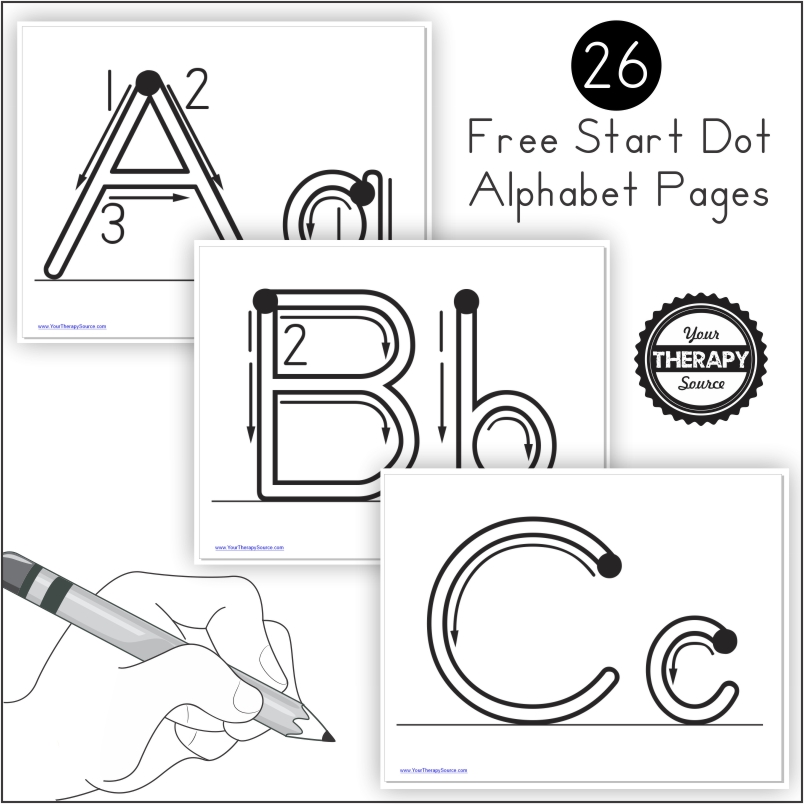Alphabet Handwriting Practice PDF Freebie with Start Dots and Arrows

Wow! This is a huge alphabet handwriting practice PDF freebie with start dots and arrows that you can use to help your students practice proper letter formation. It includes 26 pages, one for each capital and lowercase letter of the alphabet. The alphabet handwriting practice pages are outline letters, with a starting dot and arrows for the letter strokes.
Why Practice Writing the Letters of the Alphabet?
Students NEED Handwriting Practice for Letter Recognition
Did you know that research indicates that handwriting experience plays a crucial role in the formation of the brain network that underlies letter recognition?
Brain imaging studies indicated that only after the printing training did the visual regions that later become specialized in the literate individual for letter recognition become active.
Additional brain imaging results in 6 year old children helped researchers determine that only when the letters were self-produced did seeing the letters recruit the perceptual-motor network.
The researchers concluded that handwriting experience plays a crucial role in the formation of the brain network that underlies letter recognition (James, 2017).
Students NEED Alphabet Handwriting Practice to Improve
The Canadian Journal of Occupational Therapy published a review of the interventions used to improve handwriting. After reviewing 11 studies that tested relaxation and practice with or without EMG, sensory-based training without handwriting practice, and handwriting-based practice (including sensory-focused or cognitive focused handwriting practice) the researchers concluded that interventions that did not include handwriting practice and those that included less than 20 practice sessions were ineffective (Hoy, 2011).
Students NEED Pencil and Paper Handwriting Practice
The Journal of Occupational Therapy, School and Early Intervention published a small study comparing traditional handwriting practice versus iPad handwriting instruction. For the 12 kindergartners and first graders who participated, the results indicated that traditional methods of handwriting instruction were superior in terms of letter formation and letter orientation when compared to iPad-mediated practice. In addition, letter recognition increased for those using traditional handwriting methods but stayed stable for the iPad-mediated group (Wells, 2016).
Students NEED to Be Taught Handwriting Skills
Educational Psychology Review performed a comprehensive analysis to determine if teaching handwriting enhanced legibility and fluency and resulted in better writing performance. The results indicated that when compared to no instruction or non-handwriting instructional conditions, teaching handwriting resulted in statistically greater legibility and fluency. Motor instruction did not produce better handwriting skills but individualizing handwriting instruction resulted in statistically significant improvements in legibility. Handwriting instruction produced statistically significant gains in the quality, length, and fluency of students’ writing (Santangelo, 2016).
Download your FREE Alphabet Handwriting Practice PDF
Sign up below to receive the weekly email newsletter along with other announcements from Your Therapy Source. You will be redirected to the FREE alphabet handwriting practice PDF 28 page digital resource.
Suggestions for the Handwriting Practice Pages
Download and print the pages. Here are a few suggestions of how to use the alphabet handwriting practice PDF:
- Laminate the pages and use wipe off markers to start at the dot and follow the arrows for the letter strokes.
- For younger children, practice using play dough to make the letters on the laminated mats.
- Try placing different objects on top of the letter such as small buttons or glass stones.
- Rainbow write the letters using different colored crayons or markers to practice letter formation.
- Print four to a page to make the letters smaller to differentiate the activity.
References:
Hoy, M. M., Egan, M. Y., & Feder, K. P. (2011). A systematic review of interventions to improve handwriting. Canadian Journal of Occupational Therapy, 78(1), 13-25.
James, K. H. (2017). The Importance of Handwriting Experience on the Development of the Literate Brain. Current Directions in Psychological Science, 26(6), 502-508.
Santangelo, T. & Graham, S. A Comprehensive Meta-analysis of Handwriting Instruction. Educ Psychol Rev (2016) 28: 225. doi:10.1007/s10648-015-9335-1
Wells, K. E., Sulak, T. N., Saxon, T. F., & Howell, L. L. (2016). Traditional versus iPad-mediated handwriting instruction in early learners. Journal of Occupational Therapy, Schools, & Early Intervention, 9(2), 185-198.



